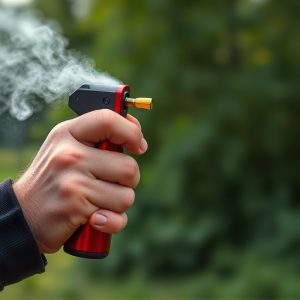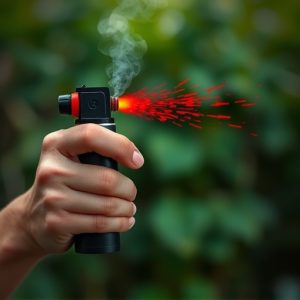Low Light Pepper Spray Tactics: Effective Crowd Control Revealed
Low light pepper spray tactics have emerged as a vital non-lethal crowd control measure for law enfo…….
Low light pepper spray tactics have emerged as a vital non-lethal crowd control measure for law enforcement in dimly lit or high-tension scenarios, such as night demonstrations and riots. Utilizing oleoresin capsicum (OC) spray, these tactics cause temporary blindness and respiratory distress, enabling officers to regain control while minimizing harm to both police and civilians. Effective deployment involves strategic aiming at the eyes and face, with specialized equipment ensuring minimal impact on bystanders and maximum incapacitation of targets. Rigorous training in fogging techniques is crucial, especially in low-visibility conditions. Law enforcement agencies increasingly rely on these tactics for crowd dispersion without causing permanent harm, prioritizing comprehensive training to maximize effectiveness while minimizing risks.
In today’s dynamic law enforcement landscape, low light pepper spray tactics have emerged as a crucial tool for crowd control. This versatile agent offers unique advantages in challenging environments where visibility is limited. Understanding its mechanism and effectiveness is paramount. This article delves into the intricacies of low light pepper spray, exploring tactical considerations, safety protocols, and responsible deployment strategies to ensure its optimal use by law enforcement agencies.
- Understanding Low Light Pepper Spray: A Tool for Crowd Control
- The Mechanism and Effectiveness of Pepper Spray in Crowded Spaces
- Tactical Considerations: When and How to Deploy Pepper Spray
- Safety and Training: Ensuring Responsible Use of Pepper Spray by Law Enforcement
Understanding Low Light Pepper Spray: A Tool for Crowd Control
Low light pepper spray tactics have become a valuable addition to law enforcement agencies’ crowd control arsenal. This specialized spray is designed to be effective in dimly lit or low-visibility conditions, which are common during night demonstrations, riots, or other high-tension situations. Its precision and non-lethal nature make it a preferred choice for managing crowds without causing permanent harm.
When deployed, low light pepper spray creates a temporary blindness and respiratory distress, allowing officers to gain control of agitated groups. These tactics require training and strategic planning to ensure the safety of both police and civilians. Proper usage involves aiming for the eyes and face, where the spray can quickly incapacitate individuals while minimizing its impact on bystanders.
The Mechanism and Effectiveness of Pepper Spray in Crowded Spaces
Pepper spray, chemically known as oleoresin capsicum (OC), is a powerful crowd control tool used by law enforcement in low light pepper spray tactics to manage and disperse large gatherings. When deployed, it interacts with the eyes, nose, and respiratory system of individuals present in crowded spaces. The OC spray contains capsaicin, the active ingredient that causes a burning sensation and temporary incapacitation. In enclosed or semi-enclosed areas, pepper spray can quickly clear a space by temporarily blinding and disorienting people, allowing police to gain control and ensure safety.
The effectiveness of pepper spray in crowded spaces lies in its ability to create a rapid and controlled environment shift. In such settings, traditional crowd control methods may struggle due to limited visibility and the difficulty of maintaining order. Low light pepper spray tactics employ specialized equipment, like air-powered canisters or hand-held sprayers, to project the spray precisely and efficiently. This ensures that individuals are temporarily disabled while minimizing harm, enabling police to manage the situation swiftly and effectively.
Tactical Considerations: When and How to Deploy Pepper Spray
In low-light scenarios, pepper spray can be a powerful tool for crowd control, offering tactical advantages that complement other non-lethal options. The effectiveness of low light pepper spray tactics lies in its ability to disrupt and disorient crowds quickly, providing crucial time for law enforcement to gain control or retreat if necessary. Its rapid onset of effects makes it particularly useful in confined spaces or when dealing with aggressive individuals who pose an immediate threat.
Deployment strategies should consider proximity and aim. In low-light conditions, visual aids may be limited, so training in fogging techniques becomes paramount. Officers should practice aiming for the face and eyes, as this area is highly sensitive to capsaicin, the active ingredient in pepper spray. Maintaining a safe distance while ensuring the target is within the spray’s range ensures effectiveness without risking collateral damage or exposure to the agent.
Safety and Training: Ensuring Responsible Use of Pepper Spray by Law Enforcement
In the realm of crowd control, law enforcement agencies increasingly rely on low light pepper spray tactics to maintain public safety during high-pressure situations. This non-lethal force option is designed to disrupt and disperse crowds without causing permanent harm. However, responsible use requires rigorous training and strict protocols. Officers must be adept at assessing crowd dynamics, understanding the range and effects of pepper spray, and employing it effectively in low light conditions—a skill set that demands continuous practice and refinement.
Training programs should cover various scenarios, including how to manage resistance, account for wind direction, and ensure the safety of both officers and bystanders. Familiarity with different types of pepper spray, their active ingredients, and de-escalation techniques are essential. By prioritizing comprehensive training, law enforcement can maximize the effectiveness of low light pepper spray while minimizing risks and ensuring a balanced approach to crowd control.
In conclusion, low light pepper spray tactics have proven to be a valuable asset for crowd control, offering both effectiveness and safety in crowded spaces. Understanding the mechanism behind this tool, its strategic deployment, and ensuring proper training and safety protocols are essential for law enforcement agencies. By embracing these practices, police can maintain public order while mitigating risks, making low light pepper spray a game-changer in modern crowd management strategies.


